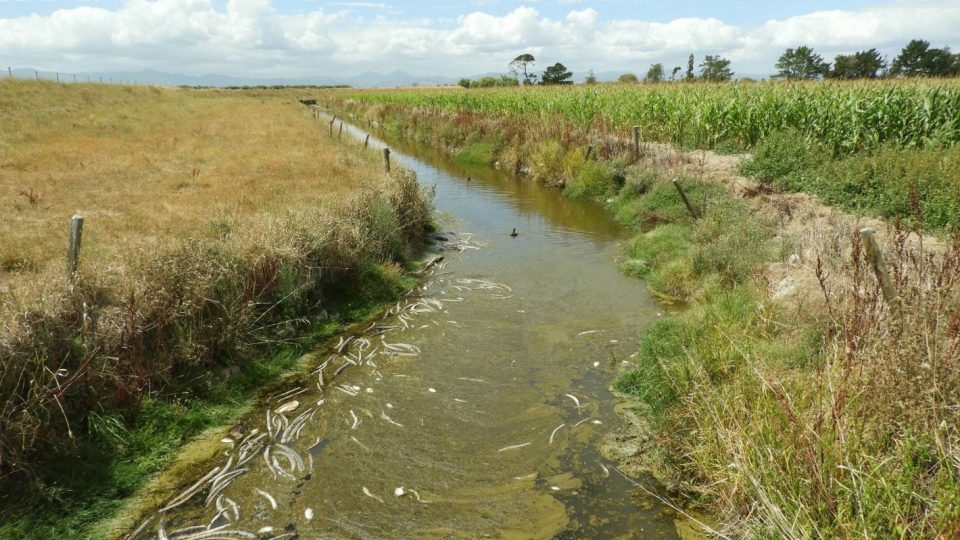FISH AND GAME/SUPPLIED
Green, polluted streams leading to fish kills could become a more frequent scenario in the Waikato River catchment as climate change hits.
More death streams might be coming.
Conditions leading to bird and fish deaths are likely to occur more and more in the Waikato River catchment as temperatures rise with climate change, a Waikato Regional Council Scientist says.
It comes as heat, algal blooms and silted floodgates contributed to a devastating avian botulism outbreak on the Hauraki Plains, killing thousands of birds and scores of eels.
Streams in parts of the Hauraki Plains had reached 29 degrees, which with high nutrient levels triggers algal outbreaks – lowering oxygen in the water and killing eels, in turn fuelling botulism.
READ MORE
* Hauraki Plains’ drains of death
* Algal bloom likely cause of red knots’ ill health in the Firth of Thames
* Ducks ‘dying like flies’ in reserves on Auckland’s North Shore due to avian botulism
Over 3500 ducks were discovered dead from the botulism, spread by infected maggots, and bird species including spoonbills, shags, red knots and herons have also been affected.
Waikato Regional Council science manager Mike Scarsbrook said high water temperatures, low flows and low oxygen levels had been seen elsewhere in the Waikato River catchment.
“What we’ve seen in Hauraki is a particular perfect storm of conditions – really hot temperatures, record low flows and the right conditions for the botulism to occur.”
FISH AND GAME/SUPPLIED
Scores of eels died due to the algal blooms and low oxygen in the water. Dead fish are thought to have contributed to the botulism.
It’s not a sure thing these outbreaks are going to happen, Scarsbrook said, but warming temperatures will see the conditions repeat.
Areas around Rangiriri and in the Ake Ake basin were at risk, where a lot of small waterways had very low flows in summer.
“It’s a significant issue across large parts of the Waikato region,” Scarsbrook said.
Fish and Game Auckland-Waikato gamebird manager David Klee said while he had not seen fish kills in other areas of Waikato this summer, they could occur in the future.
Fish deaths are linked with botulism outbreaks, because they provide the botulism bacteria with a protein-based material to flourish.
“Fish kills will occur in other drainage networks as well.
“A lot of these drains up here are greener than the grass due to algal blooms. When you get that in a drain you get dissolved oxygen, which kills fish.”
Eels, carp, goldfish and catfish could be affected, Klee said.
“A lot of these species that we are talking about are really pollution tolerant species, so if they’re dying, it’s pretty bad.”
Who was responsible from preventing another severe outbreak was the “million dollar question,” Klee said.
“The district and regional councils are the ones that have the ability to change the management of drainage systems.
“But we have to try and work out how we can be more resilient to fit within what the climate is going to throw at us.”
FISH AND GAME/SUPPLIED
Over 3500 ducks have died in the Hauraki Plains due to avian botulism, feeding on infected maggots which spread the disease.
Scarsbrook said Waikato Regional Council were looking at drainage and waterway management.
“A lot of these areas have been drained in the past up to 150 years ago.”
We need to think about balancing drainage for land use and flood protection, against the environmental impacts on wildlife.
Council need to monitor a good spread of sites across lowland areas in the region, Scarsbrook said.
“This is something we need to come to terms with and better manage with climate change.”
More riparian planting in parts of the stream network would provide shading from hot temperatures and refuge for wildlife, he said.
WAIKATO REGIONAL COUNCIL/SUPPLIED
Regional Council science manager Mike Scarsbrook said waterways with low dissolved oxygen and low flows was a big issue across the region.


